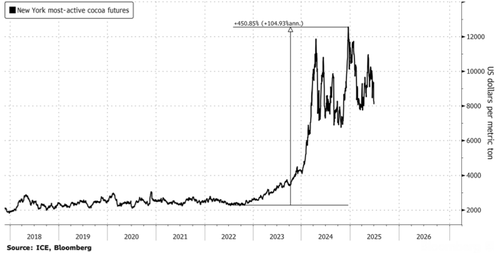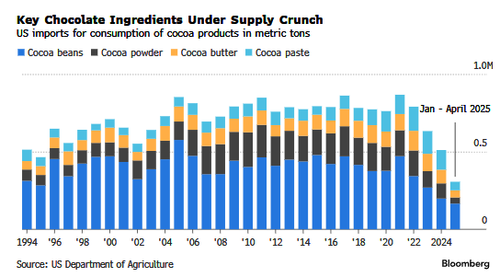
Cocoa Supply Crunch Shown In One Chart
The chocolate industry is facing a new era of chronic shortages and record-high prices across cocoa beans, butter, powder, and paste, sparking structural supply disruptions across North America and Europe. At the heart of the crisis is West Africa, where countries such as Côte d’Ivoire, Ghana, Nigeria, and Cameroon—responsible for 75% of global cocoa production—have been severely impacted by years of adverse weather and crop diseases.
Cocoa bean prices in New York remain near record highs—trading around $8,000 a ton on Tuesday—after skyrocketing over 450% from late 2022 to December 2024, when prices briefly topped $12,000. This surge has driven a 16% increase in key input costs for chocolate makers so far this year, putting additional upward pressure on candy prices at the supermarket.

One of the most striking visualizations of the multi-year cocoa shortage, courtesy of Bloomberg, is the decline in U.S. cocoa imports, which have seen supplies plummet in just a few short years.

In response, major food companies, such as Mars and Hershey, have reduced the sizes of candy bars, added cheaper ingredients e.g., nuts, wheat), or entirely shifted to non-chocolate offerings. Artisan producers like Raaka have reported paying a whopping triple the price for cocoa powder.
This has only kicked off a rise in substitutes for food companies, introducing cocoa powder alternatives, such as:
-
Carob blends (Doehler Group, Germany),
-
Wheat-based powder (Ardent Mills, U.S.), replacing up to 50% of cocoa powder in some products
-
Flavor and color substitutes like vanilla, caramel, coffee, and food coloring are also gaining traction.
“We are in an era where chocolate indulgence will no longer rely solely on cocoa,” Ina Dawer, the global insight manager for ingredients at Euromonitor International, told Bloomberg.
The global cocoa shortage is expected to persist: Cocoa processing in Europe, the largest international market, declined 3.7% in 1Q25 to its lowest level since 2017, while a similar trend has been observed in North America. Coca bean prices are expected to remain elevated through the second half of the year.
Tyler Durden
Thu, 07/10/2025 – 02:45


















